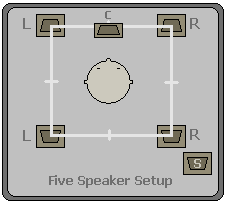 |
|
|
|
In the Forums... |
Posted: April 10, 2000 Written by: Tuan "Solace" Nguyen Dolby Digital 5.1 Also known as AC-3 -- which is Dolby's encoding system, Dolby Digital is a surround system that stores all channels separately. Left, Right, Center, Behind-Left, Behind-Right, and Low Frequency Effects are all stored on their own respective channels. Its full name is Dolby Digital 5.1. The 5 stating that there are fives speakers, and the .1 is for the Low Frequency Effects or subwoofer. Because its response range is limited to frequencies below 120Hz and not the entire 20Hz to 20KHz, it is denoted with .1. The AC-3 system can be thought of as an MP3 encoding format where it discards sounds that are supposedly inaudible to the human ear to reduce on data file size. DTS Abbreviation of Digital Theater Systems, DTS is similar to Dolby Digital. DTS is designed to be used with DVD audio and could also be used with multichannel audio CDs. DTS encodes and compresses the audio data like AC-3 but does so without discarding as much information as AC-3. However, Dolby Digital is more widely used. To be able to listen to full Dolby Digital or DTS from your PC, you must have a soundcard with a S/PDIF (Sony/Philips Digital Interface Format) output that supports AC-3 or DTS. You can then pipe the cable to a discrete six speaker capable receiver that can decode AC3 or DTS. Some newer soundcards can down mix AC3 signals for use on quad outputs and virtualizes the missing center channel.  Surround Sound Slow Down Out of all the surround sound formats just discussed, rarely any are used as an interactive medium in games. This is because the decoding algorithms for AC-3 and DTS are so complex that it would take too long to decode and output to listening to keep up with what is happening onscreen. Consequently, this is the reason why Dolby Digital and DTS are mainly used for pre-rendered cinematic soundtracks. Enter the world of Positional 3D Sound. As games became more sophisticated and gamers became more sophisticated of what games they were playing, developers had to come up with ways to deliver the effect of surround sound that would envelope the player and(!) be interactive at the same time. Called an API or Application Programming Interface, this software layer allows games and or applications to have direct access to the PC's hardware. Since the most complex functions are done in hardware, complex algorithms can be used to manipulate the digital signals. The few Positional 3D Sound APIs that exist include: DirectSound3D, A3D, Sensaura, and Q3D. If you know about these technologies, you may be wondering why EAX and I3DL2 are not included as "Positional 3D Sound APIs". We'll touch on the reason a little later. |
||
|
| |||
|---|---|---|---|